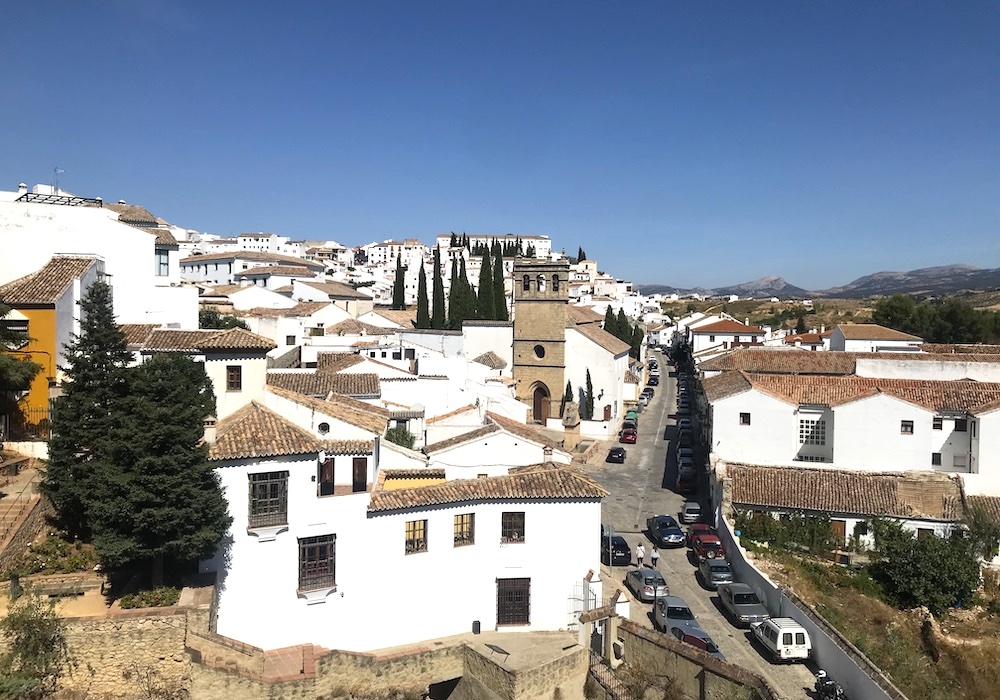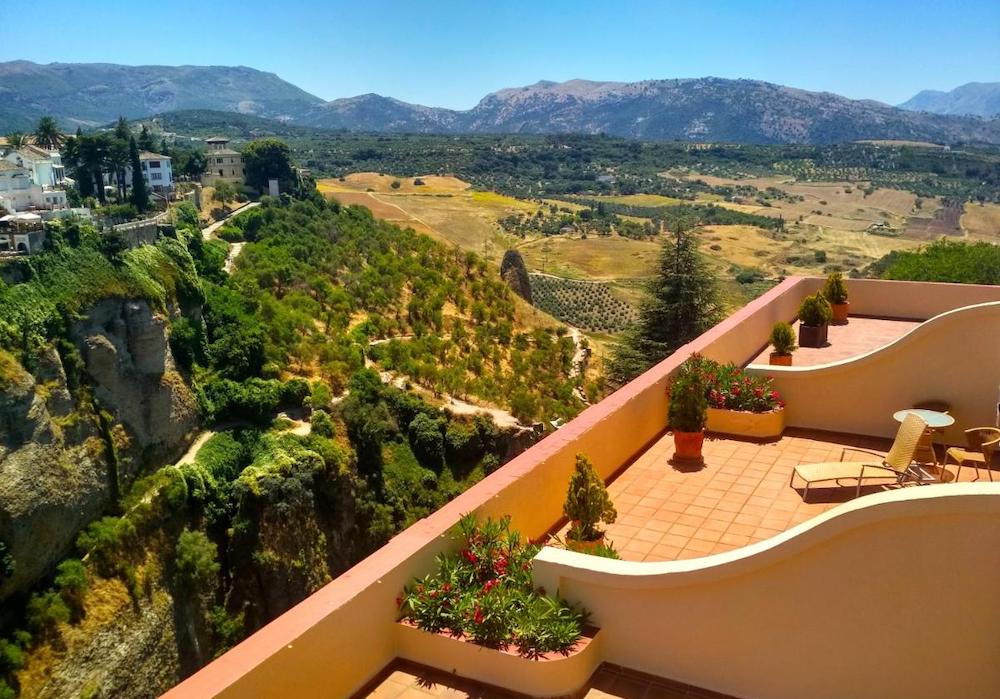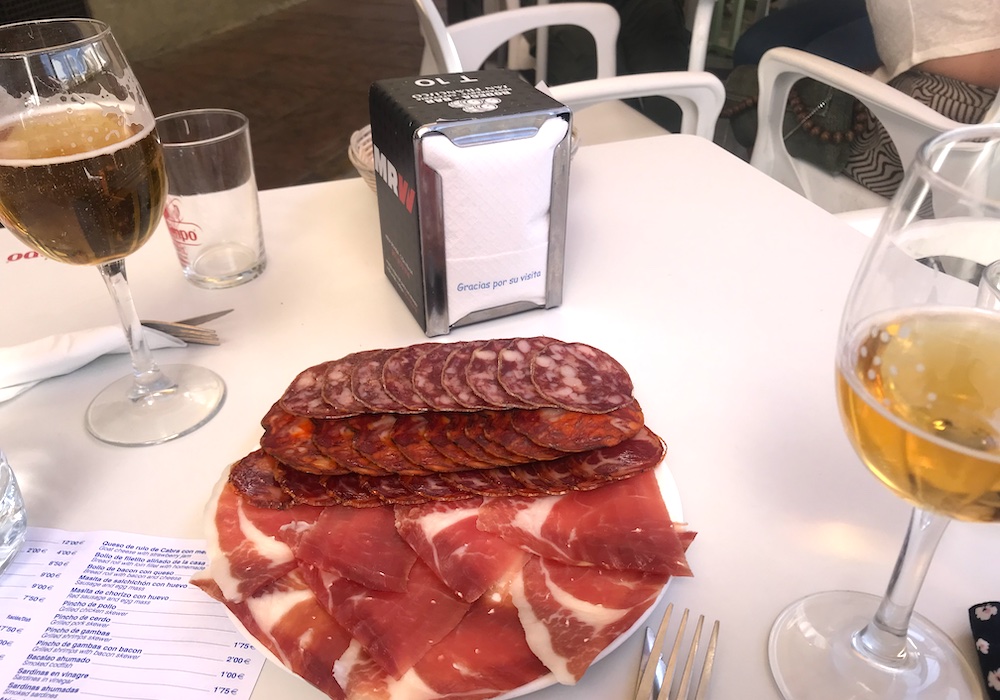Home to mosques, palaces, and the oldest bullring in Spain, this former Moorish capital is the perfect place to pause if you’re venturing inland from the sun-drenched Costa del Sol for the day.

Ronda is one of Andalusia’s loveliest Puebla Blancas (Photo: Allie D’Almo)
No matter how many pictures you’ve seen, nothing quite prepares you for the sight of the Puente Nuevo – Ronda’s 200-year-old bridge that straddles the plunging 400-ft high Tajo Gorge. The bridge connects two sections of the city, with the medieval historic heart in the south and the 17th century ‘new town’ in the north. You can take the train, but that means forfeiting one of Spain’s most exhilarating drives along the A-397 to a soaring plateau in Malaga’s mountains.
Ronda’s history is as dramatic as its setting. The Celts first settled here in the 10th Century BC, then the Romans followed by the Moors. Catholic monarchs King Ferdinand and Isabella I recaptured the town in 1485, landing one of the final blows for the Moorish Empire. A few hundred years later, the 19th century brought bandits and bullfighters, then the 20th century brought writers and artists including Orson Welles and Ernest Hemmingway. All of these influences have left their mark, securing Ronda’s position as one of Andalusia’s loveliest Puebla Blancas or ‘white towns’.
Things to do

The plunging Tajo Gorge divides Ronda in two (Photo: Allie D’Almo)
Start your day at the start of Ronda’s story in ‘La Ciudad’, the tangle of medieval streets making up Ronda’s old town. While its name suggests a Moorish king lived here, Casa del Rey Moro (Calle Cta. de Santo Domingo, 9) was actually designed in the early 20th century by the Duchess of Parcent. Famed gardener Jean Nicolas Forestire built the Moorish-style tiered gardens in 1912 and the building became a national monument in the 1940s. It’s worth visiting for the romantic gardens alone, but it’s better yet with a trip down the 200-step staircase carved into the rocks. Known as ‘La Mina’, this feature dates back to the 14th century. According to local legend, Christian troops waded through the waters and trampled up the stairs in 1485 for their final victory.
Just down the road is another remnant from the city’s Moorish past – the Banos Arabes (Calle Molino de Alarcón). Built in the 13th century, these are some of the best-preserved baths in the whole of southern Spain, complete with original horseshoe columns. There’s a helpful ten-minute video to make it easier to visualise the spa in its heyday too.
If you’re looking to dive deeper into Ronda’ history, Museo del Lara (Calle de Armiñán, 29) and Museo de Ronda (Calle de Armiñán, 59) both provide excellent insights. The latter features a staggering number of artefacts spanning at least a thousand years of history in what is surely one of the most picturesque palatial settings in the city. Museo del Lara is the informal lifetime collection of Antonio Lara Jurado, featuring inquisition artefacts, memorabilia from 1960s movies filmed in Ronda, and just about everything in between.
While you’re here, take the time to look at the two oldest bridges in Ronda. The Puente Viejo (Calle Real, 2) or ‘old bridge’ is Ronda’s second-oldest crossing, built in 1616. The Puente San Miguel (Río Guadalevín) is actually the town’s oldest bridge, known as the Roman Bridge until the end of the 15th century due to its ancient construction. Then, head to Puente Nuevo (Pl. España), the city’s newest bridge, which was built by King Felipe V in 1793. If you’ve got the stomach for it, make sure you pause to admire the stomach-churning views from halfway point.

Ronda boasts one of Spain’s most magnificent bull rings (Photo: Andy Maguire via Flickr/ CC BY 2.0)
Across the bridge in the new town, Plaza de Espagna is the city’s main square. This became a focal point during the Civil War and was immortalized in ‘To Whom the Bell Tolls’, by Hemmingway. According to local lore – and the author – a group of fascists were rounded up at the start of the Civil War in the town hall and humiliated before being thrown off the cliff. The town hall is now an upmarket hotel (Plaza España, 29400) boasting sparkling views and some beautiful gardens.
Even if you’re morally opposed to bullfighting, it’s worth taking a visit to Plaza de Toros (Calle Virgen de la Paz, 15) – Spain’s largest and oldest bullring – for an insight into this deeply Spanish tradition. Built from soft sandstone, the arena has seen some of the most important and controversial events in bullfighting history. A guided tour will take you through the stockyards, dressage ring and pens, and out into the vast open ring, which measures a staggering 66 metres in diameter. The Museo Taurino (Calle Virgen de la Paz, 15), part of the enclosure, is worth lingering over too. As well as costumes and memorabilia charting the ring’s 300-year history, there are original artworks from Picasso and Dali advertising the spectacle.
Where to stay

Views from the rooms at Parador de Ronda (Photo: Booking.com)
Despite being one of the worst-kept secrets in Spain, Ronda offers a wide range of surprisingly affordable accommodation. For a cheap and cheerful nights’ sleep, try Hotel San Francisco (Calle María Cabrera, 18). Less than a 10-minute stroll from Ronda train station, it’s also within spitting distance of the city’s blockbuster sights. There is a range of bright, light-filled rooms on offer, from basic double rooms to spacious family rooms. Thoughtful extras, such as toiletries, chocolates and a wake-up service go a long way too. Booking.com
For something a little special, Parador de Ronda (Plaza de España) has an atmosphere in spades. It may have played a rather gruesome role in the Civil War, but you wouldn’t be able to tell from its gleaming marble and luxuriously furnished interiors. There are 78 rooms to choose from, many boasting views over the Puente Nuevo. There’s a large pool and manicured gardens too. Days here start with a generous breakfast in the drawing room and end out on the terrace, with a glass of local wine overlooking the sparkling city. Booking.com
If you’re travelling with a car and want to get a flavour of the surrounding countryside, Molino del Santo (Calle Benaoján, 29007) is hard to beat. Founded in 1987, this rural retreat is just a 20-minute drive southwest of the city. Set amidst olive trees and swooping oaks, right next to a bubbling river, it’s the perfect base for those looking to explore the Sierra de Grazalema park. Owners Andy Chapell and Pauline Elkin are only too happy to help with hiking routes and advice too. The restaurant is as popular with locals as it is with out-of-towners. Booking.com
Eat and drink

Some of Ronda’s most enchanting culinary experiences are the simplest, particularly those at Bodega San Francisco (Photo: Allie D’Almo)
Ronda has dozens of exciting restaurants to rave about, but some of its greatest culinary offerings are the simplest. Take the terrace restaurant at Hotel Montelirio (Calle Tenorio, 8), where you can start the day sitting in the sun with sweeping views of the Tajo Gorge and a steaming cup of cafe con leche. Opt for the classic ‘pan con tomate’ too – fresh crusty bread served with crushed tomatoes and a pot of extra-virgin olive oil for you to use as liberally as you like, without judgement.
Bodega San Francisco (C. Comandante Salvador Carrasco) doesn’t look like much from the outside, but then the best tapas restaurants never do. Hidden down a backstreet off the main trail, this cafe-cum-restaurant is mostly frequented by locals. It’s nearly always at full capacity but service is far from sloppy, with plates arriving as and when they’re ready. Most tapas dishes are very reasonably priced at €1-2, while a large plate of Iberian ham will only set you back a little over €10. Take a look at the counter for daily hot tapas specials and wash it all down with a frosted caña, a small glass of local beer.
For those who have tired of traditional tapas, there’s Tragatá (Calle Nueva, 4, 29400). Run by the celebrated Catalan chef Benito Gomez, you can have a high-end dining experience for a fraction of the prices at Bardal, Gomez’ signature restaurant in Ronda. Tapas here is bold and innovative, with creative takes on Andalusian ingredients, such as salmon marinated in lime and vanilla. Main dishes are equally exciting, with dishes like roasted marrow with beef tartar and Japanese-style duck tataki with soy, seaweed, ginger and mushrooms. Interiors are just as stylish as the menu, featuring tartan-covered booth-style seating and metro-tiled walls.